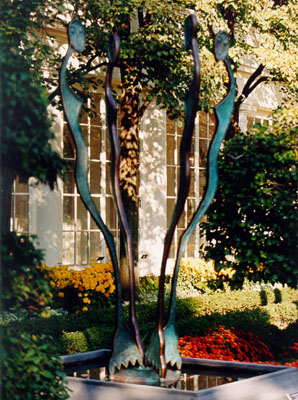John Hoover (Aleut) b. 1919
"Sea Weed People," c. 1994
Bronze, 9' x 4' diameter
The Heard Museum, Phoenix, Arizona
John Hoover is a contemporary of Allan Houser's. He credits Houser for
encouraging his work. It was Houser that recommended Hoover for a teaching
position at the newly established Institute of American Indian Art (IAIA) in
the early 1960s. Hoover and Houser also shared the same gallery and dealer.
Their careers grew together.
However, each artist worked with the subject they knew best, their
own cultural heritages. Hoover was born and raised in Alaska. Like many Aleut
young men of his generation, he became a commercial fisherman. He continues to
fish the cold waters of Alaska during the season. The images he incorporates
into his sculptures are from the stories and histories of the peoples of
Alaska. His themes are connected to the relationship between man and the spirit
world. His work has often been referred to as shamanistic. Many of his pieces
are representations of this state of transformation.
"Sea Weed People," is an example of his visual representation of the
spirithelpers that assist the Aleut people. It gracefully represents four
humanistic sea weed forms that float upwards and out to capture their grace and
movement.
Garden Exhibit VI Home Page
